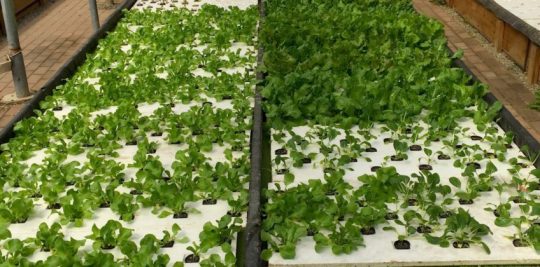Don't wanna be here? Send us removal request.
Photo

What is the use of controllers installing in a greenhouse and hydroponic system?
Hydroponics involves growing plants without soil, using mineral nutrients in an aqueous solution. With the help of a hydroponic controller system, the controllers make it easier for the growth of plants reducing the workflow and saving time. It involves minimal human intervention. Automated controllers besides monitoring the plant-specific parameters also control the conditions by triggering activities in associated equipment with the provision of sending notifications to the end-user. Some of these types of controllers are designed to perform tasks such as – dosing, irrigation, lighting, fertigation, climate, etc. There are various types of controllers available which can help perform the task and give expected results. Some of them are: Irrigation Controller The Irrigation Controller manages the irrigation pumps and solenoid control valves that are part of the greenhouse nutrient system. Climate Controller The Climate Controller provides a stress-free cultivation environment for crops by preventing a sudden change in climate conditions. Dosing Controller The dosing controller automates the dosing operations of your hydroponic farm. It can manage the pH, EC, Temperature [optional], and Dissolved Oxygen [optional] levels in the nutrient solution, according to the specified set values.
#Greenhouse#hydroponics system#hydroponics#hydroponic#leafygreens#plants#garden#gardening#sharing#love plants#growing plants#controller#hydroponic setup#setup#zeptogreens
0 notes
Photo

Growing plants and fishes in the same environment is both art and science. This can be made into a commercially profitable business by the use of greenhouse technology. A greenhouse protects its interiors from being exposed the adverse climatic conditions such as wind, cold, precipitation, excessive radiation, extreme temperature, insects, and diseases. Thus, a microclimate created inside a greenhouse act as a catalyst for the sustainable rearing and cultivation of leafy green plants and ornamental fish in any place and in all climates of the year.
The greenhouse space is efficiently utilized to position large tanks for ornamental fish rearing, breeding, and grow beds are placed on top of these tanks for growing leafy green plants. In this integrated farming technique, the water in the fish tank which is enriched in ammonia and other minerals over time from the waste discharged by fish is pumped to the plant grow bed to be utilized as nutrient solution. This water is recirculated back to the fish tank after plants absorb the nutrients. This system is a self-sustainable organic model which requires minimal intervention as it relies mostly on the mutual symbiosis of fish, bacteria, and plants.
The leafy green plants suitable for such an environment are broccoli, lettuce, spinach, swiss chard, rosemary, mint, etc. Studies are being conducted to grow tomato, lady’s finger, and brinjal as well as other indigenous plants that can act as substitute for a variety of currently imported greens. Among the Ornamental fishes, the fish that are suitable for rearing and breeding in such an environment are Koi carps, Goldfish, Catfishes, Loaches, Indigenous barbs, mollies, guppies, platy, swordtail, etc. Thus, greenhouse aquaponics offers a dual-income possibility from fish and plants which can be reaped throughout the year.
#greenhouse#aquaponics system#leafygreens#marine life#fruits and vegetables#indoor farming#hydroponics#farming
3 notes
·
View notes
Link
Non -commercial / Small scale (Rooftop Gardening)
Commercial / Medium Scale (Rooftop Farming)
Commercial /Large Scale (Rooftop agriculture)
A hydroponic rooftop greenhouse can produce the maximum yield vis-à-vis the three rooftop growing categories mentioned above. The structure of the greenhouse can comprise of glass, rigid plastic, polythene or acrylic. Controlled Environment conditions are maintained inside the glasshouse with the help of heaters, coolers, ventilation fans, sensors. Depending on the location and construction of the plant factory and availability of sunlight the need to install artificial lighting requirements can be considered.
The heat island effect caused by urban buildings through reflection of sunlight or by emission of heat from interior air conditioning can be mitigated by the rooftop greenhouse as it can act as an insulation cover and the heat can be utilized to maintain the temperature of the nutrient solution. Thus effectively the rooftop greenhouse has the potential to reduce the power consumption costs of the whole building.
#hydroponics#greenhouse#green leafy vegetables#healthy vegetables#indoor farming#garden#farming#leafygreens
1 note
·
View note
Photo

#leafygreens#greenhouse#green leafy vegetables#healthy vegetables#health & fitness#plants#indoor farming#garden#farming
2 notes
·
View notes
Photo

1 note
·
View note
Link

The greenhouse space is efficiently utilized to position large tanks for ornamental fish rearing, breeding, and grow beds are placed on top of these tanks for growing leafy green plants. In this integrated farming technique, the water in the fish tank which is enriched in ammonia and other minerals over time from the waste discharged by fish is pumped to the plant grow bed to be utilized as nutrient solution. This water is recirculated back to the fish tank after plants absorb the nutrients. This system is a self-sustainable organic model which requires minimal intervention as it relies mostly on the mutual symbiosis of fish, bacteria, and plants. The leafy green plants suitable for such an environment are broccoli, lettuce, spinach, swiss chard, rosemary, mint, etc. Studies are being conducted to grow tomato, lady’s finger, and brinjal as well as other indigenous plants that can act as substitute for a variety of currently imported greens. Among the Ornamental fishes, the fish that are suitable for rearing and breeding in such an environment are Koi carps, Goldfish, Catfishes, Loaches, Indigenous barbs, mollies, guppies, platy, swordtail, etc. Thus, greenhouse aquaponics offers a dual-income possibility from fish and plants which can be reaped throughout the year.
3 notes
·
View notes